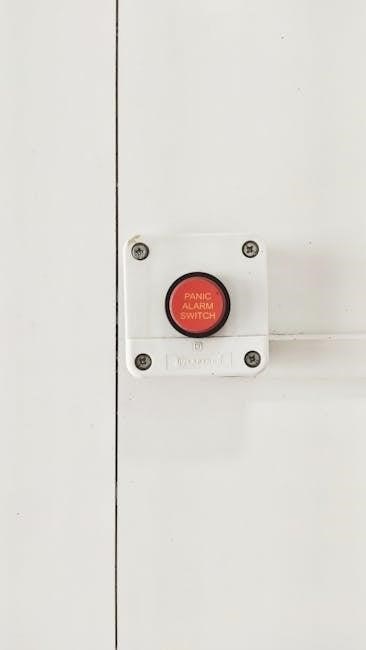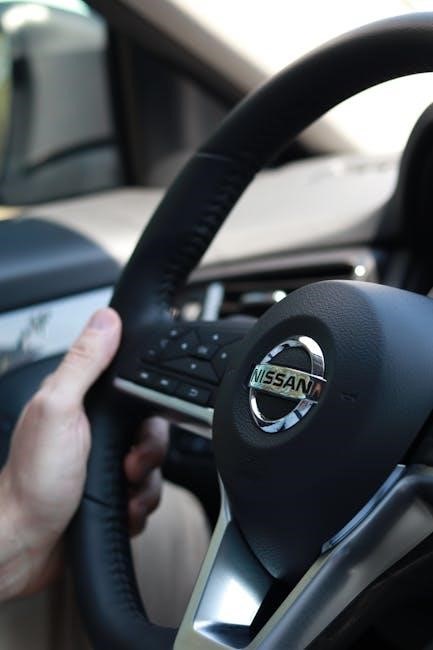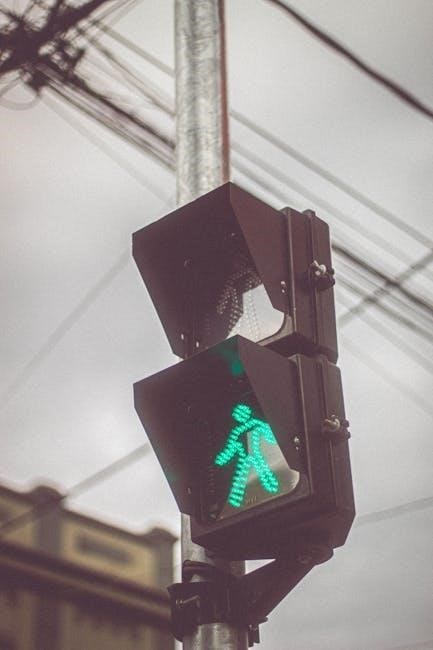
The Nissan Sentra “See Owner’s Manual” warning indicates a system malfunction, often linked to faulty sensors or software glitches. Addressing it promptly is crucial for safety and performance;
1.1 Understanding the “See Owner’s Manual” Warning
The “See Owner’s Manual” warning on a Nissan Sentra indicates a system malfunction or issue requiring attention. This message often appears due to problems like faulty sensors, software glitches, or water ingress in the driver-side cowl area. It serves as a prompt to consult the owner’s manual for guidance on resolving the issue. Ignoring this warning can lead to further complications, including safety risks or system damage. Understanding the underlying cause is essential for proper troubleshooting and ensuring the vehicle operates safely and efficiently. Always refer to the manual or contact a certified technician for assistance. Regular inspections and addressing recalls, such as the Takata airbag inflator issue, can prevent such malfunctions and maintain your vehicle’s reliability.
1.2 Importance of Addressing the Malfunction Promptly
Addressing the “See Owner’s Manual” warning promptly is critical to ensure the Nissan Sentra operates safely and efficiently. Ignoring the issue can escalate into more severe problems, such as airbag system failures or electrical malfunctions. The warning often indicates underlying issues like faulty sensors or water ingress, which, if untreated, can lead to costly repairs. Delaying action may also compromise safety features, increasing the risk of accidents. Regular inspections and timely repairs are essential to maintain the vehicle’s reliability and protect its occupants; Consulting the owner’s manual or an authorized Nissan service center can provide clear guidance and prevent further complications. Proactive maintenance ensures peace of mind and keeps the Sentra performing at its best.

Common Causes of the Nissan Sentra Warning Malfunction
The warning malfunction is often caused by faulty Takata airbag inflators, water ingress in the driver-side cowl area, or software glitches in Nissan’s intelligent systems.
2.1 Takata Airbag Inflator Recall and Its Implications
Nissan issued a “do not drive” warning for over 80,000 Sentra models due to defective Takata airbag inflators. These inflators can rupture during deployment, causing metal fragments to injure occupants. The recall affects 2002-2006 Sentra models and is part of a larger Takata airbag crisis impacting millions of vehicles worldwide. The defect poses a critical safety risk, especially in frontal collisions. Nissan urges owners to avoid driving their vehicles until repairs are made. Dealers will replace the faulty inflators free of charge. This recall highlights the importance of addressing safety-related issues promptly to prevent potential harm to drivers and passengers.
2.2 Water Ingress Issues in the Driver-Side Cowl Area
Water ingress in the driver-side cowl area is a common issue in some Nissan Sentra models, leading to warning malfunctions. This occurs when heavy rain or flooding causes water to seep into the cowl area due to a missing or improper seal. Over time, moisture can damage electrical components, triggering warning lights on the dashboard. This issue has prompted recalls, as water exposure can lead to system failures, including airbag malfunctions. Drivers are advised to avoid prolonged exposure to heavy rain and to inspect for signs of water damage. Repairing or replacing the cowl seal is often necessary to prevent further complications. Addressing this issue promptly ensures the vehicle’s safety systems remain reliable and functional.
2.3 Faulty Sensors and Their Role in Triggering Warnings
Faulty sensors are a common cause of the Nissan Sentra warning malfunction. These sensors monitor critical systems like airbags, tire pressure, and engine performance. When they fail or malfunction, the car’s computer detects anomalies and triggers warning lights. For instance, a defective oxygen sensor or airbag sensor can activate the “See Owner’s Manual” alert. Moisture ingress or electrical issues often damage these sensors, leading to inaccurate readings. Ignoring these warnings can result in further system failures or safety risks. Regular sensor inspections and replacements are essential to prevent such malfunctions. Addressing sensor-related issues promptly ensures reliable vehicle operation and safety on the road.
2.4 Software Glitches in the Nissan Intelligent Mobility System
Software glitches in the Nissan Intelligent Mobility system can trigger the “See Owner’s Manual” warning. These issues often arise from outdated or corrupted software affecting safety features like automatic emergency braking and blind-spot monitoring. Symptoms include intermittent warning lights and unexpected system deactivation. Updating the vehicle’s software to the latest version typically resolves these glitches. However, persistent problems may require professional diagnostic checks. It’s essential to address such malfunctions promptly to ensure the proper functioning of advanced safety technologies and maintain driver confidence. Regular software updates are recommended to prevent future occurrences and keep the system functioning optimally.

Diagnostic Steps for the Warning Malfunction
Check the owner’s manual for guidance, use an OBD-II scanner to identify error codes, inspect for water ingress, and consult Nissan experts for precise troubleshooting.

3.1 Checking the Owner’s Manual for Specific Guidance
Consulting the owner’s manual is the first step in addressing the “See Owner’s Manual” warning on your Nissan Sentra. The manual provides detailed explanations of warning lights and error codes, helping you identify the specific issue. It includes step-by-step troubleshooting guides tailored to your vehicle’s systems, such as the Nissan Intelligent Mobility features. Additionally, the manual outlines scheduled maintenance recommendations to prevent future malfunctions. By referencing the manual, you can determine whether the issue requires immediate attention or if it can be resolved through simple steps. Always follow the manual’s instructions carefully and contact Nissan support if further assistance is needed. This ensures safety and proper functioning of your vehicle’s advanced systems. Regularly reviewing the manual helps you stay informed about your car’s upkeep and safety features. This proactive approach enhances your driving experience and prevents potential hazards.
3.2 Using OBD-II Scanners to Identify Error Codes
Connecting an OBD-II scanner to your Nissan Sentra can quickly identify the root cause of the “See Owner’s Manual” warning. This tool retrieves specific error codes from the vehicle’s onboard computer, providing clarity on issues like faulty sensors, airbag malfunctions, or software glitches. Once connected, the scanner displays codes such as “B1026” or “B1036,” which may indicate problems with the airbag system or electrical components. These codes guide technicians to inspect specific areas, such as the driver-side cowl for water ingress or defective sensors. Addressing these issues promptly ensures safety and prevents further system damage. Always consult a professional if unfamiliar with interpreting or resolving the codes.
3.3 Inspecting for Water Damage or Moisture in Electrical Components
Inspecting for water damage or moisture in electrical components is critical, as water ingress can trigger warning malfunctions. Start by examining the driver-side cowl area, as recalls have highlighted improper seals that allow water entry during heavy rain. Check for visible signs of moisture, corrosion, or water droplets on wiring, sensors, and modules. Use a flashlight to inspect hard-to-reach areas, and gently probe for soft or damp spots. If water damage is found, disconnect the battery to prevent short circuits. Addressing this issue promptly can prevent further electrical failures and ensure system reliability. Regular inspections, especially after exposure to heavy rain or flooding, can help identify and resolve water-related issues early. This step is essential for maintaining the integrity of the Nissan Sentra’s electrical systems and avoiding recurring warning malfunctions.
3.4 Consulting with Authorized Nissan Service Centers
Consulting authorized Nissan service centers is a critical step in diagnosing and resolving the “See Owner’s Manual” warning malfunction. These centers have trained technicians with access to specialized tools and the latest software updates. They can accurately identify issues such as faulty sensors, water ingress, or software glitches. Additionally, they can address recalls, like the Takata airbag inflator recall, ensuring compliance with safety standards. By using genuine Nissan parts and following factory-recommended procedures, they guarantee reliable repairs. Owners should prioritize visiting these centers for complex malfunctions, as they provide a comprehensive diagnosis and solutions tailored to the vehicle’s specific needs. This ensures the warning system operates correctly and maintains overall vehicle safety.

Possible Solutions to Resolve the Malfunction
Replace defective Takata airbag inflators, repair water ingress in the cowl area, update software, and reset the warning system after addressing the root cause.
4.1 Replacing Defective Takata Airbag Inflators
Replacing defective Takata airbag inflators is critical to ensure passenger safety. These inflators may rupture due to propellant degradation, causing injury. Nissan has issued recalls for affected models, including the Sentra, due to this risk. Owners should contact authorized service centers to verify if their vehicle is part of the recall. Technicians will replace the faulty inflators with updated, safe components free of charge. Ignoring this issue can lead to airbag malfunction during accidents, increasing the risk of harm. Prompt action is essential to restore the vehicle’s safety features and comply with manufacturer recommendations. Always prioritize airbag system integrity to protect occupants in the event of a collision.
4.2 Repairing or Replacing the Driver-Side Cowl Seal
Water ingress in the driver-side cowl area is a common issue that triggers the “See Owner’s Manual” warning. This occurs when the seal is damaged or improperly installed, allowing moisture to penetrate and affect electrical components. Nissan has issued recalls for this specific problem, emphasizing the need for prompt action to prevent further malfunctions.
Repairing or replacing the cowl seal involves inspecting the area for signs of water damage or corrosion. If the seal is compromised, it must be replaced to ensure proper waterproofing. Additionally, any affected electrical components should be cleaned or replaced to restore system functionality. It is recommended to consult a Nissan-authorized service center for precise repairs, as improper installation can lead to recurring issues.
Addressing this problem not only resolves the warning but also prevents potential safety risks associated with malfunctioning systems. Regular inspections can help identify such issues early, ensuring the vehicle remains reliable and safe on the road.
4.3 Updating the Vehicle’s Software to the Latest Version
Updating the Nissan Sentra’s software to the latest version is essential for resolving malfunctions related to the “See Owner’s Manual” warning. Outdated software can cause system glitches, such as faulty sensor readings or airbag warnings. Nissan regularly releases software updates to improve the performance of its Intelligent Mobility features, including Safety Shield 360. These updates often address issues like water ingress detection or Takata airbag inflator recalls. To update, owners can visit authorized Nissan service centers or use over-the-air updates if available. Always follow the instructions in the owner’s manual for guidance. Ensuring the software is up-to-date helps restore system functionality and prevents future warnings from appearing unnecessarily.
4.4 Resetting the Warning System After Repairs
After addressing the malfunction, resetting the warning system is essential to clear any error codes. This ensures the system operates correctly and prevents unnecessary alerts. Use an OBD-II scanner to reset the system or follow the steps in the owner’s manual. If the issue was resolved professionally, the service center will typically handle the reset. However, if you’ve made repairs yourself, consult the manual for specific instructions. In some cases, a simple ignition cycle (turning the key on and off) may reset the system. Always verify that the warning light turns off and test the vehicle to ensure the repair was successful. If the light reappears, further diagnostic work may be needed.

Preventative Measures to Avoid Future Malfunctions
Regular inspections, avoiding prolonged water exposure, and software updates can prevent future issues. Adhering to scheduled maintenance ensures optimal performance and safety.
5.1 Regular Maintenance and Inspections
Regular maintenance is essential to prevent Nissan Sentra warning malfunctions. Routine checks ensure all systems function properly, reducing the risk of unexpected issues. Inspect the vehicle’s electrical components, especially after exposure to water, as moisture can trigger warnings. Check the driver-side cowl area for proper sealing to prevent water ingress, a common cause of malfunctions. Additionally, ensure all sensors are clean and free from damage, as faulty sensors can activate warning lights. Stay updated with scheduled maintenance recommendations from Nissan to address potential problems early. Regular inspections help identify and resolve issues before they escalate, ensuring safety and reliability on the road.
- Inspect electrical components for moisture or damage.
- Check the driver-side cowl seal for integrity.
- Clean and test sensors to ensure accuracy.
- Follow Nissan’s recommended maintenance schedule.

5.2 Avoiding Prolonged Exposure to Heavy Rain or Flooding
Prolonged exposure to heavy rain or flooding can lead to water ingress in the Nissan Sentra’s electrical systems, particularly in the driver-side cowl area. This can trigger warning malfunctions and safety issues. To prevent this, park your vehicle in covered areas during heavy rainfall and avoid driving through flooded roads. Regularly inspect the cowl drain for blockages and ensure proper sealing. If water exposure occurs, have the vehicle inspected by a professional to check for moisture in electrical components. Prompt action can prevent long-term damage and maintain your car’s reliability on the road.
5.3 Keeping the Vehicle’s Software Up-to-Date
Regular software updates are essential for maintaining the Nissan Sentra’s advanced systems, including safety features and warning systems. Outdated software can lead to malfunctions, such as the “See Owner’s Manual” warning. Staying current ensures optimal performance and addresses potential glitches. Nissan often releases updates to improve functionality and resolve issues. Drivers can check for updates through the NissanConnect system or by visiting an authorized service center. Keeping the software up-to-date not only prevents warning lights but also enhances overall vehicle safety and reliability. It’s a proactive step to avoid unexpected issues and ensure all systems operate as intended.

The Role of the Owner’s Manual in Troubleshooting
6.1 Navigating the Owner’s Manual for Warning Light Explanations
The owner’s manual provides detailed explanations for warning lights, helping drivers identify issues like the “See Owner’s Manual” alert.
6.2 Step-by-Step Troubleshooting Guides
- Offers diagnostic steps for common malfunctions.
- Guides on resetting systems after repairs.
6.3 Scheduled Maintenance Recommendations
Outlines routine checks to prevent future issues, ensuring optimal vehicle performance and safety.
The Nissan Sentra owner’s manual provides detailed explanations for warning lights, helping drivers identify issues promptly. It outlines the meaning of each light, such as the “See Owner’s Manual” alert, and offers step-by-step guidance for troubleshooting. For instance, the manual explains how water ingress in the driver-side cowl area or faulty sensors can trigger warnings. It also directs users to specific sections for resolving issues like updating software or addressing Takata airbag recalls. By referring to the manual, drivers can understand the severity of the malfunction and take appropriate actions, ensuring safety and preventing further damage. This resource is essential for diagnosing and addressing warning-related problems effectively.
The owner’s manual provides detailed troubleshooting steps for the “See Owner’s Manual” warning. Start by checking the manual for specific error code explanations. Next, use an OBD-II scanner to identify the issue. If water ingress is suspected, inspect the driver-side cowl area for moisture. For airbag-related warnings, refer to the Takata recall section. Update the vehicle’s software if glitches are detected. After addressing the issue, reset the warning system. If unresolved, consult an authorized Nissan service center for professional assistance. These guides help drivers identify and resolve malfunctions efficiently, ensuring safety and optimal vehicle performance.
Regular maintenance is key to preventing warning malfunctions in the Nissan Sentra. The owner’s manual outlines a detailed schedule, including oil changes, tire rotations, and inspections of critical systems like brakes and electrical components. Staying on top of these tasks ensures optimal vehicle performance and reduces the risk of unexpected issues. Additionally, routine software updates for the Nissan Intelligent Mobility system can resolve glitches that may trigger warnings. By following the recommended maintenance plan, drivers can identify and address potential problems early, minimizing the likelihood of encountering the “See Owner’s Manual” alert while driving. Consistency in upkeep not only enhances safety but also extends the lifespan of the vehicle.

Nissan’s Recall and Warning Notifications
Nissan has issued recalls for Takata airbag inflators and water ingress issues, warning owners to address these defects promptly to ensure safety and prevent further complications.
7.1 Overview of the Takata Airbag Recall
Nissan issued a “do not drive” warning for over 80,000 vehicles, including certain Sentra models, due to defective Takata airbag inflators. These inflators can rupture, increasing injury risk. The recall affects 2002-2006 Sentra, Pathfinder, and Infiniti vehicles. Owners are urged to avoid driving until repairs are made. Nissan is replacing the faulty inflators to ensure safety. This critical action highlights the importance of addressing recalls promptly to prevent potential harm. The Takata recall underscores the need for vigilance in maintaining vehicle safety and adhering to manufacturer guidelines.
7.2 Water Ingress Recall and Its Implications
Nissan issued a recall for certain Sentra models due to water ingress in the driver-side cowl area, which can lead to electrical malfunctions. This issue often triggers warning lights and system errors, potentially causing safety risks. The recall affects vehicles where improper sealing allows water to enter during heavy rain or flooding, damaging sensors and electronic components. This can result in faulty airbag warnings and other critical system failures. Owners are advised to address this promptly to prevent further complications. Nissan recommends inspecting and repairing the cowl seal to ensure proper functionality and safety. Ignoring this recall could lead to more severe issues, emphasizing the importance of timely maintenance and adherence to manufacturer guidelines.
7.3 Other Manufacturer-issued Warnings and Advisories
Beyond the Takata airbag recall and water ingress issues, Nissan has issued additional warnings for the Sentra. These include advisories related to software updates for the Nissan Intelligent Mobility system, which may cause unexpected warning lights. Some models have also been flagged for potential electrical system malfunctions due to faulty sensors or wiring harnesses. Owners are encouraged to stay informed about these advisories through official Nissan communications or their local dealerships. Regular software checks and system updates are recommended to prevent such issues. Additionally, Nissan has emphasized the importance of adhering to all safety guidelines and addressing any warning lights promptly to ensure vehicle reliability and occupant safety on the road.

Addressing the “See Owner’s Manual” warning promptly ensures safety and optimal performance. Regular maintenance, software updates, and vigilance are key to preventing future malfunctions and enhancing driving security.
8.1 The Importance of Driver Vigilance and Proactive Maintenance
Driver vigilance and proactive maintenance are essential to ensure the Nissan Sentra operates safely and efficiently. Regular inspections, such as checking for water ingress or software updates, can prevent malfunctions. Monitoring warning lights and addressing them promptly helps avoid escalating issues. Proactive maintenance not only enhances safety but also extends the vehicle’s lifespan. Drivers should stay informed about recalls and follow the owner’s manual guidelines to maintain optimal performance. Vigilance behind the wheel and consistent upkeep are key to minimizing risks and ensuring reliability on the road.
8.2 Ensuring Safety on the Road
Addressing the “See Owner’s Manual” warning promptly is vital for maintaining road safety. Ignoring it can lead to critical system failures, such as airbag malfunctions or impaired braking systems, increasing accident risks. Nissan’s Safety Shield 360, standard in newer models, relies on proper functionality to provide features like automatic emergency braking and blind-spot warnings. Drivers must ensure all recalls, such as the Takata airbag inflator replacement, are addressed to prevent life-threatening issues. Regular inspections and software updates also play a key role in preventing unexpected system failures. By staying proactive, owners can safeguard themselves and others on the road, ensuring their Nissan Sentra operates reliably under all conditions.
8.3 Staying Informed About Recalls and Updates
Staying informed about recalls and updates is essential for maintaining your Nissan Sentra’s safety and performance. Regularly check Nissan’s official website or sign up for recall notifications to stay updated on any issues affecting your vehicle. For instance, the Takata airbag recall and water ingress issues in the driver-side cowl area highlight the importance of prompt action. Additionally, keeping your vehicle’s software up-to-date ensures the latest safety features and bug fixes are installed. Referencing your owner’s manual or consulting with authorized service centers can also provide guidance on addressing recalls and performing necessary updates. Proactive monitoring helps prevent potential malfunctions and ensures your Sentra remains reliable and safe on the road. By staying informed, you can address issues before they escalate and enjoy a hassle-free driving experience.